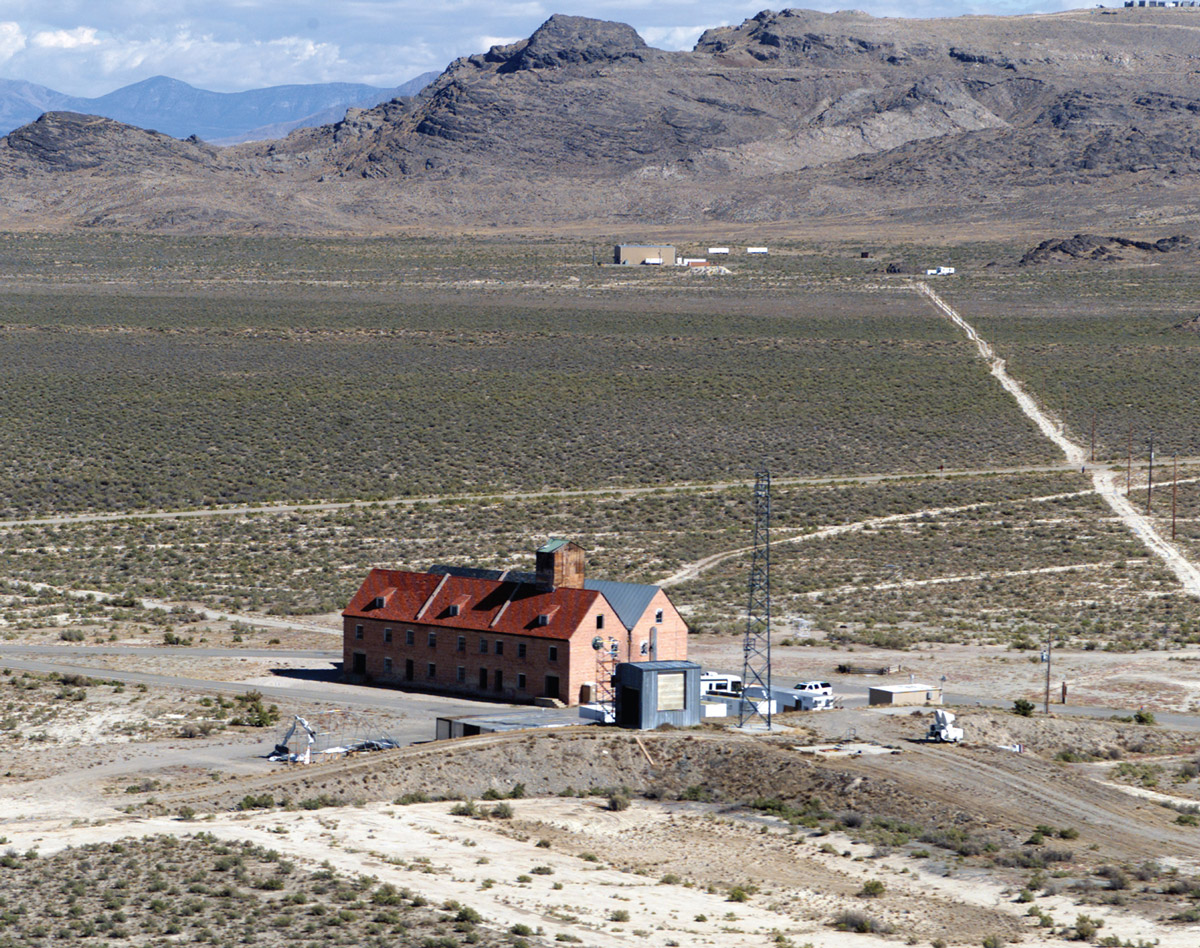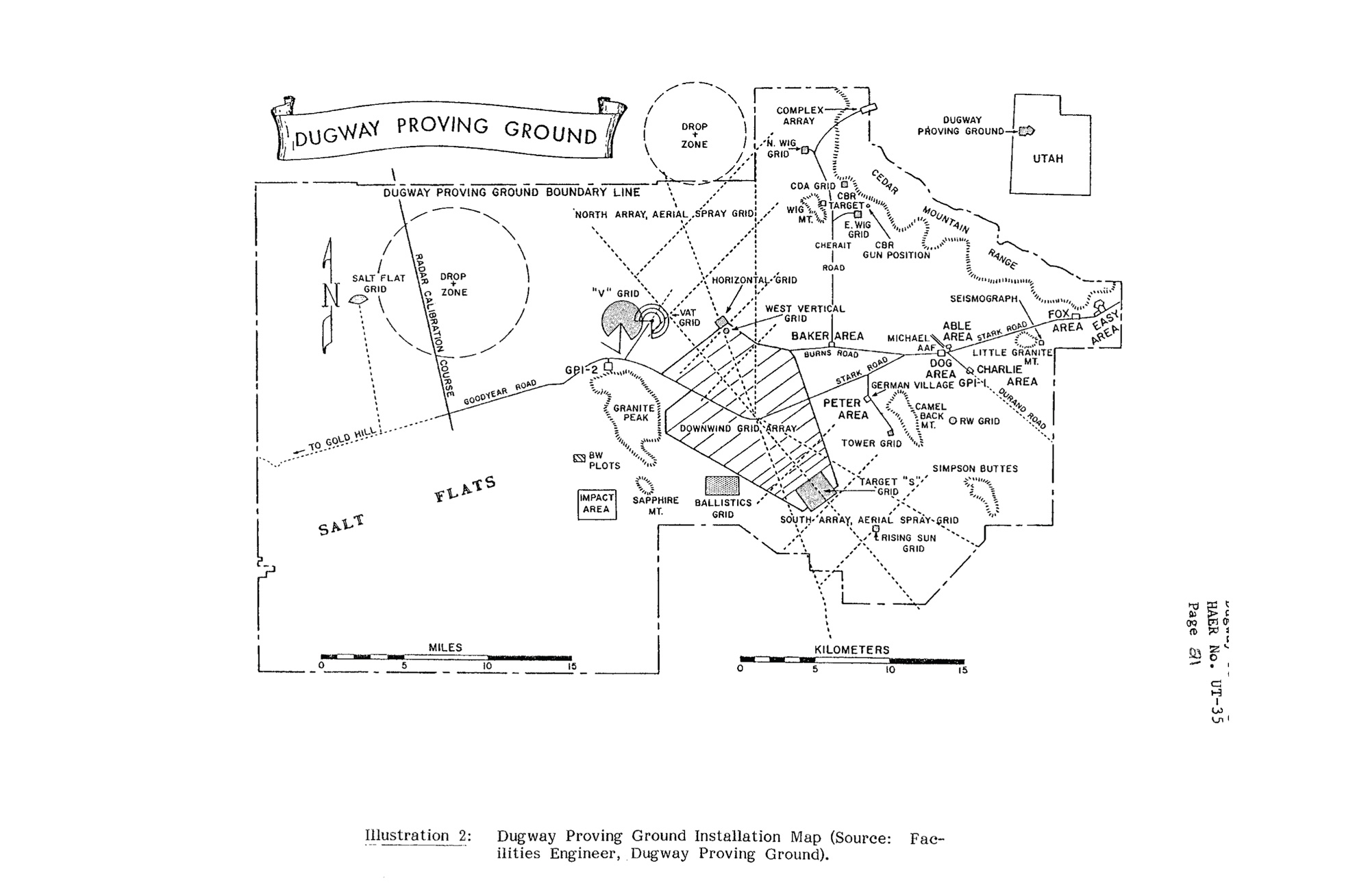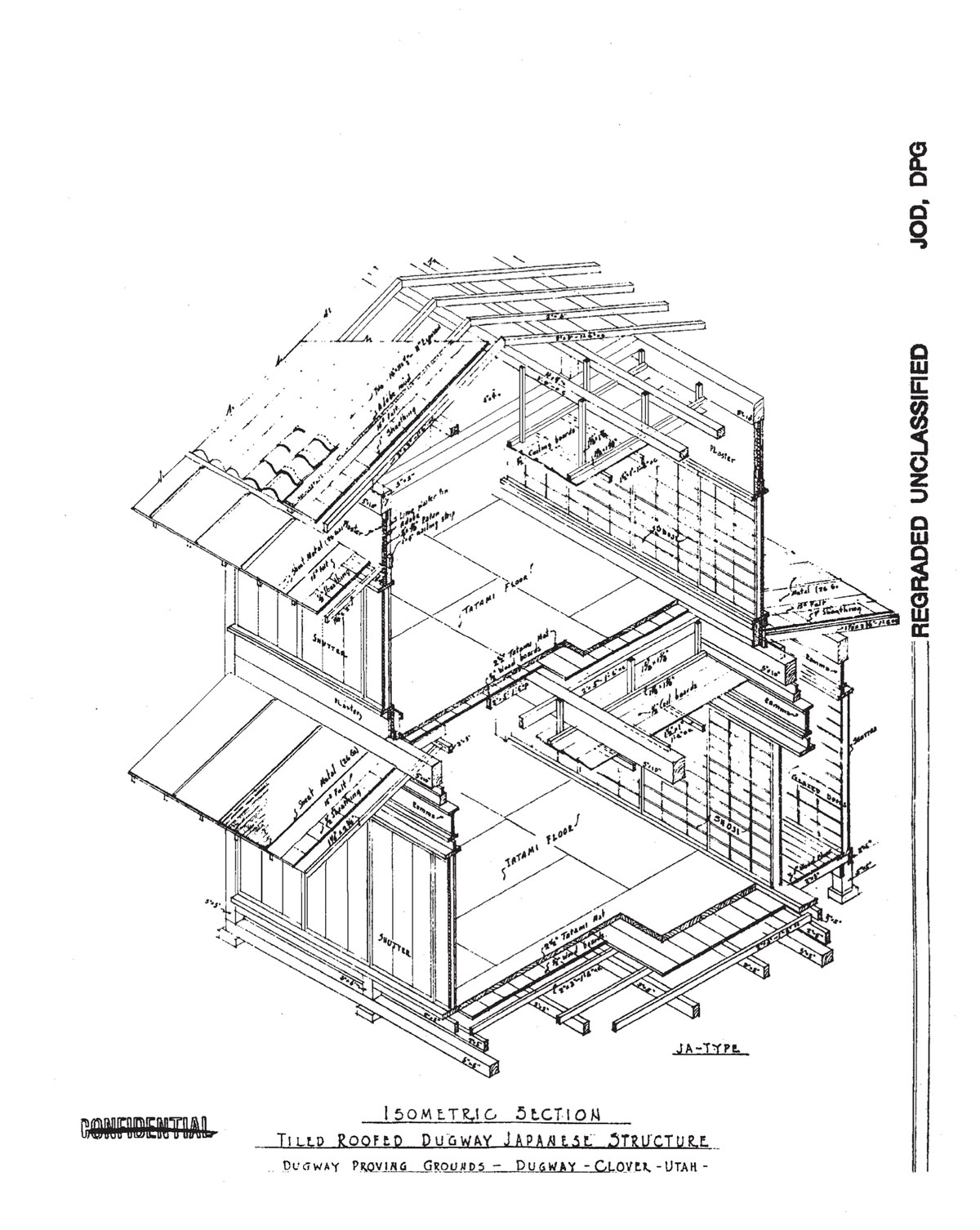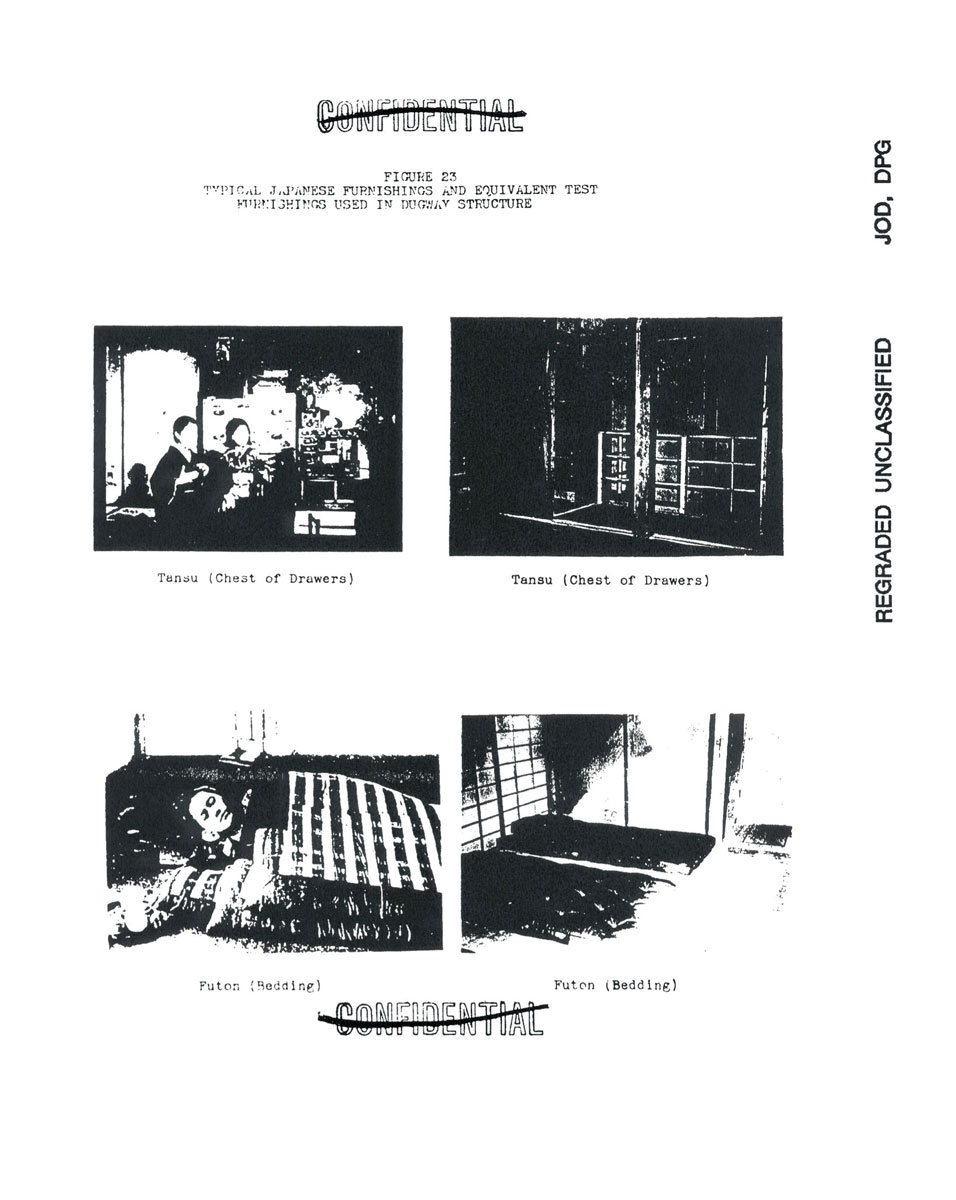Burning Down the House: The German-Japanese Village
World War II bomb testing in Utah
An Architektur

During World War II, the Allied armed forces began developing methods to test new weapon systems in situations close to reality. The low effectiveness of conventional air raids led the US Army to intensify the testing of incendiary bombs. At first, already existing farm buildings on army sites were used for the tests, but the resulting data proved unreliable because the way in which the bombed structures burned was not comparable to the burning patterns of actual targets. In order to gain useful data from the tests, the military started to build its own test structures, and in the spring of 1943, began erecting detailed reproductions of typical German and Japanese housing forms at a Utah site called the Dugway Proving Ground.
The development and construction of this building complex, the so-called German-Japanese Village, produced an architecture that represents an inversion of the original buildings’ function: transforming them from environments intended for dwelling to test objects of destruction. From the arrangement and spatial plans of the buildings to their furnishings, the design plan of the German-Japanese Village follows a logic that results from the objectives and requirements of the incendiary bombing tests—it is a realistic simulation, yet it creates its own building type within a particularized set of military parameters.
The Czechoslovakian architect Antonin Raymond, who worked several years in Japan (including a stint in Frank Lloyd Wright’s office) developed the planning basis of the Japanese Village. The emigré Jewish architects Erich Mendelsohn and Konrad Wachsmann consulted on the planning of the German Village—Mendelsohn, well known for his buildings in Berlin, was excluded from the Prussian Art Academy in 1933 and emigrated first to London, later to Israel and, in 1941, to the United States; Wachsmann fled to France and reached the US shortly before the occupation with the help of Albert Einstein, where he joined Walter Gropius to work on the development of prefabrication systems. Several unnamed architects affiliated with the “Gropius Group” at Harvard also participated in the research studies on typical German city structures and building constructions that accompanied the planning of the German Village.
Mendelsohn, Wachsmann, and Raymond likely never worked on the actual site. Instead they developed the planning concept—Mendelsohn provided a survey of typical constructional organization of German industrial and residential buildings, as well as information on construction details; Wachsmann gave advice on the choice of wood for the German Village and confirmed Mendelsohn’s data; while Raymond designed the structural makeup and details for the Japanese Village and advised on the choice of materials.
Participating in the development and construction of the German-Japanese Village were governmental agencies such as the Army Corps of Engineers, the National Defence Research Committee (NDRC), and the Chemical Warfare Service (CWS), as well as private corporations such as the Standard Oil Development Company, producer of the incendiary bombs, and civil consultants called in because of their knowledge of building structures in Germany and Japan. A local contractor was charged with the construction work for the three test blocks as well as an observation bunker, a temporary office and warehouse, a water tank, and a pipeline; they were also given the responsibility for supplying replacement materials and repairing the damage caused during the tests. Prisoners of the nearby Utah State Prison were used as construction workers. In May 1943, the German-Japanese Village was completed after only 44 days.
Contrary to its name, the German-Japanese Village did not simulate a village. Rather, it consisted of three building units. One of these blocks simulated a German mietskaserne, or tenement house; the other two resembled Japanese housing. The blocks were erected 40 feet apart in order to prevent flames from spreading from one building to another during the tests and to allow firefighters better access. An observation bunker was placed at a distance of 450 feet. Both blocks of the Japanese Village were composed of six two-story single-family homes with bases of either 122 by 61 feet or 144 by 50 feet and separated by an alleyway typical of Japanese building arrangements. The German Village consisted of two buildings with bases of 60 by 106 feet constructed back-to-back, both of which had their own roof truss. There were six apartments on each floor, separated by firewalls. Following the parameters of the tests—just the upper floors of the mietskasernen can be reached by the bombs and so there was no need for the lower floors to be constructed—the buildings consisted of only two stories rather than the five more typical of the German originals, outwardly suggesting rural rather than urban dwellings.
More important than the simulation of specific German or Japanese dwelling forms was the faithful reproduction of construction methods and material characteristics, both of which obviously influence the way the buildings react to fire. Both blocks of the Japanese Village were erected as wooden framework construction with separating walls of roughcast adobe bricks. They differed basically in the kind of roofing: in one case, burned tiles on wooden planks plastered with clay; in the other, tin on wooden planks. According to the planners, this construction corresponded with approximately 65 percent of all Japanese residential buildings. The two elements of the German Village were constructed as one solid stonework building with a ceiling of wooden beams, again with two different roof types—one corresponding to a slate-over-sheeting construction style found in the Ruhr Valley, the other featuring tiles, a method predominant in Berlin mietskasernen. The adjacency of these two types of building has no analogue in any actual Germany city—the arrangement only exists as a simulation for the purpose of the tests; optimized, and completely fictitious. It is a composite, as was stressed in the planning papers, of the relevant characteristics of approximately 80 percent of the residential housing in central and northern Germany.

Above and following: Courtesy Dugway Proving Ground, Optical Data Branch.


In order to assure an exact correspondence between the kind of wood used at Dugway and the original materials, American, German, and Japanese wood types were analyzed and compared with regard to their aging processes, specific density, and humidity; in analyzing the effects of the climate on the burning process, dates were taken from the Handbook of Climatology, a meteorological study of German industrial cities done in 1932. All relevant factors—from temperature and air humidity to the moisture content of the material—were repeatedly checked during the tests and their effects on the average time of combustion and the duration of the fire of all structural elements were analyzed. To compensate for the dry climate of Utah, the buildings were moistened artificially with steam radiators to simulate a building situation in the more humid German climate.
The German-Japanese Village not only simulated the means of construction and the use of material of the original buildings—the rooms were also outfitted with the appropriate furniture to analyze their effects on the combustibility and the burning processes of the houses. For this purpose, detailed studies were made documenting the culturally determined forms of inhabitation in typical interiors analyzing the average number of pieces of furniture per room, the resulting weight on the floor, the materials used, and so on. In the analysis of Japanese buildings and interiors, images of typical living situations were supplemented with lists of pieces of furniture, which described their purpose and also suggested American equivalents. During firebomb tests at the Japanese Village, tatami mats came to be of particular importance. Since they covered large parts of the floor, the mats had an effect on the impact of the bombs and the combustibility of the buildings. For the tests, either imported originals were used or replicas made out of agave fibers, whose characteristics were very close to those of the original material.
In contrast to the Japanese Village, where the buildings themselves consisted of some 70 percent of burnable material, the burning processes of the German Village were mainly determined by the furniture. The air raids flown on German cities prior to 1943 had shown that the edifices of the mietskasernen were difficult to set alight and so experiments were conducted on how an entire building could best be burned from the inside out. Analyses were carried out on exactly where the firebombs should land in the rooms, if and how they ignited the furniture, as well as the intensity and duration of the resulting fire and its process of spreading. The furniture for the German Village was selected according to the assumed living situation of an average working class family: a large room was furnished as a combination of a living and eating room, the two smaller ones as kitchen and sleeping room. The amount and distribution of the furniture was to be as similar to the real German households as possible; its design was supervised by two employees of the “Authenticity Division” of RKO Studios in Hollywood who had produced the interiors for the blockbuster Hitler’s Children. In total, 19 different pieces of furniture—tables, beds (including mattresses and bolsters), cupboards and chairs—were designed and manufactured in cooperation with manual workers trained in Germany. Nevertheless, the furniture of the German Village didn’t exactly correspond to an authentic interior. The authenticity mentioned in the documentation only relates to the factors relevant to the firebomb tests like material, humidity, and size; not to the finish and appearance or the function as a utilitarian object.
Based on the tests at the German-Japanese Village, firebombs were developed in accordance with the different specific characteristics of the targets. The bombs were filled with flammable chemicals, which upon impact were dispersed throughout the building. In order to distribute the firebombs over a vast area, so-called cluster bombs were developed which exploded while still in the air—the explosion set free smaller firebombs contained in the cluster bombs. In the German Village, every single room was to be hit in order to create as many sources of combustion as possible; previous tests had shown that the walls between and within the apartments retarded the spread of fire. Other bombs were developed for the attacks on the Japanese village; those used in the attacks on German mietskasernen were too heavy for the lighter-built Japanese buildings, chopping through them and landing in the soil below.
After World War II, parts of the buildings at Dugway served as test facilities for chemical and biological weapons. One room is sealed due to contamination caused during those tests, others are partly used as Army storage. In autumn 1994, all buildings on the Dugway Proving Ground were analyzed and documented on behalf of the Historic American Engineering Record (HAER) for potential conservation and preservation. The German Village was designated for protection. Today, only the two mietskasernen of the German Village and one observation bunker are preserved.
Bibliography
Leonard J. Arrington & Thomas G. Alexande, “Sentinels on the Desert,” Utah Historical Quarterly, vol. 32, no. 1 (1964).
David Buchanan & John Johnson, HAER No. UT-35, Historic American Engineering Record, “Dugway Proving Ground” (1984).
Carey and Co., Inc. & Desert Research Institute, Stabilization Report: The German Village, Dugway Proving Ground, Tooele County, Utah (2001).
Mike Davis, “Angriff auf ‘German Village,’” in Der Spiegel (28 November 1999).
Antonin Raymond, An Autobiography (Rutland, VT: Charles E. Tuttle Co., 1973).
Standard Oil Company, Design and Construction of Typical German and Japanese Test Structures at Dugway Proving Grounds, Utah (1943).
Tom Vanderbilt, Survival City: Adventures among the Ruins of Atomic America (New York: Princeton Architectural Press, 2002).
Konrad Wachsmann & Michael Grüning, Der Architekt Konrad Wachsmann - Erinnerungen und Selbstauskünfte (Vienna: Löcker Verlag, 1986).
Karen Weitze, HAER No. UT-35-A and HAER No. UT-92, Historic American Engineering Record, “German-Japanese Village” (1995).
An Architektur is a Berlin-based journal on the production and use of the built environment. In summer 2004, An Architektur will organize the “Camp for Oppositional Architecture,” an international three-day open conference that will promote a critical approach and agency in the field of architecture and planning. For further information, visit anarchitektur.com [link defunct—Eds.].
Spotted an error? Email us at corrections at cabinetmagazine dot org.
If you’ve enjoyed the free articles that we offer on our site, please consider subscribing to our nonprofit magazine. You get twelve online issues and unlimited access to all our archives.